 As we saw in the blog post last month, Eurozone becalmed the doldrums, the eurozone economy is stagnant and there is a growing danger that it could sink into a deflationary spiral. Last month, several new measures were announced by the ECB, including a negative interest rate on money deposited in the ECB by banks in the eurozone. This month, the ECB has gone further including, for the first time, a form of quantitative easing.
As we saw in the blog post last month, Eurozone becalmed the doldrums, the eurozone economy is stagnant and there is a growing danger that it could sink into a deflationary spiral. Last month, several new measures were announced by the ECB, including a negative interest rate on money deposited in the ECB by banks in the eurozone. This month, the ECB has gone further including, for the first time, a form of quantitative easing.
So what has been announced, and will it help to kick-start the eurozone economy? The measures were summarised by Mario Draghi, President of the ECB, at a press conference as follows:
The Governing Council decided today to lower the interest rate on the main refinancing operations of the Eurosystem by 10 basis points to 0.05% and the rate on the marginal lending facility by 10 basis points to 0.30%. The rate on the deposit facility was lowered by 10 basis points to –0.20%. In addition, the Governing Council decided to start purchasing non-financial private sector assets.
The Eurosystem will purchase a broad portfolio of simple and transparent asset-backed securities (ABSs) with underlying assets consisting of claims against the euro area non-financial private sector under an ABS purchase programme (ABSPP). This reflects the role of the ABS market in facilitating new credit flows to the economy and follows the intensification of preparatory work on this matter, as decided by the Governing Council in June. In parallel, the Eurosystem will also purchase a broad portfolio of euro-denominated covered bonds issued by MFIs domiciled in the euro area under a new covered bond purchase programme (CBPP3). Interventions under these programmes will start in October 2014.
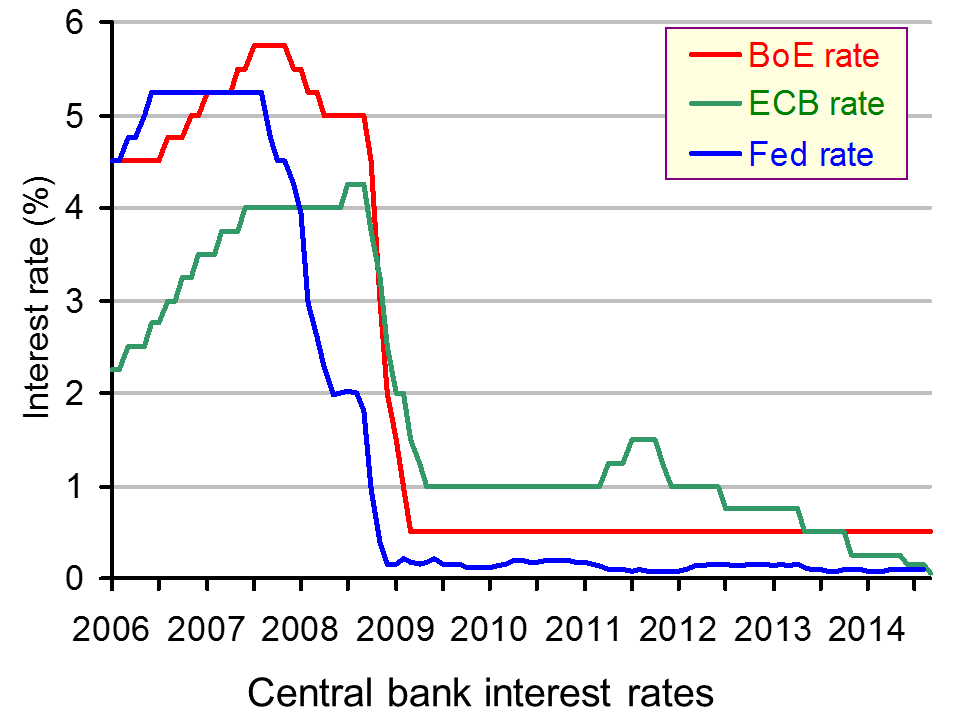
To summarise: the ECB has cut interest rates, with the main rate cut to virtually zero (i.e. 0.05%). This represents a floor to interest rates, as, according to Mario Draghi, there is now no scope for further cuts. (Click here for a PowerPoint of the chart.)
In addition, the ECB will begin the outright purchase of private-sector securities. This is a form of quantitative easing as it will involve the purchase of assets with newly created money. In the past, the ECB has simply offered loans to banks, with assets owned by banks used as collateral. This form of quantitative easing has been dubbed ‘QE light’, as it does not involve the purchase of government bonds, something the German government in particular has resisted. The ECB recognises that it would be a sensitive matter to buy government bonds of countries, such as Greece, Spain and Cyprus, which have been criticised for excessive borrowing.
Nevertheless, if it involves the creation of new money, purchasing private-sector assets is indeed a form of QE. As Mario Draghi said in response to a question on this matter:
QE is an outright purchase of assets. To give an example: rather than accepting these assets as collateral for lending, the ECB would outright purchase these assets. That’s QE. It would inject money into the system. Now, QE can be private-sector asset-based, or also sovereign-sector, public-sector asset-based, or both. The components of today’s measures are predominantly oriented to credit easing. However, it’s quite clear that we would buy outright ABS only if there is a guarantee.
So with appropriate guarantees in place about the soundness of these securitised assets, the ECB will purchase them outright.
But will these measures be enough? Time will tell, but there are now several measures in the pipeline, which could see a large stimulus to bank lending. The main question is whether banks will indeed take the opportunity to lend or merely hoard the extra reserves. And that depends in large part on the demand for credit from businesses and consumers. Boosting that is difficult when the economic climate is pessimistic.
Articles
Draghi’s ECB surprise puts off bigger quantitative easing for now Reuters, John O’Donnell (5/9/14)
ECB President Mario Draghi pulls stimulus lever at last, but still no quantitative easing for eurozone Independent, Ben Chu (5/9/14)
ECB cuts rates and launches stimulus programme BBC News (4/9/14)
Draghi Push for ECB Easing Intensifies Focus on ABS Plan Bloomberg, Stefan Riecher and Jeff Black (4/9/14)
 Draghi Sees Almost $1 Trillion Stimulus as QE Fight Waits Bloomberg, Simon Kennedy (5/9/14)
Draghi Sees Almost $1 Trillion Stimulus as QE Fight Waits Bloomberg, Simon Kennedy (5/9/14)
Draghi’s Case For ECB Quantitative Easing Forbes, Jon Hartley (8/9/14)
ECB’s last roll of the dice BBC News, Robert Peston (4/9/14)
Draghi’s eurozone steroids BBC News, Robert Peston (2/10/14)
Draghinomics – Abenomics, European-style The Guardian, Nouriel Roubini (1/9/14)
ECB Press Release
Introductory statement to the press conference (with Q&A) European Central Bank, Mario Draghi, President of the ECB (4/9/14)
 Webcast of the press conference 4 September 2014 European Central Bank, Mario Draghi, President of the ECB (4/9/14)
Webcast of the press conference 4 September 2014 European Central Bank, Mario Draghi, President of the ECB (4/9/14)
Questions
- Summarise the ECB’s monetary policy measures that will be coming into effect over the coming months.
- How does the QE announced by Mario Draghi differ from the QE that has been used by the Bank of England?
- Would it be a realistic option for the ECB to reduce its main rate below zero, just as it did with the deposit facility rate?
- What is meant by ‘securitisation’. Explain how asset-backed securities (ABSs) and covered bonds are forms of securitised assets.
- Why will the purchase of mortgage-backed securities not necessarily give a boost to the housing market?
- How does the effectiveness of any QE programme depend on what happens to the velocity of circulation of created money?
- What determines this velocity of circulation?
- Why are ‘animal spirits’ so important in determining the effectiveness of monetary policy?
- Are there any moral hazards in the ECB actions? If so what are they?
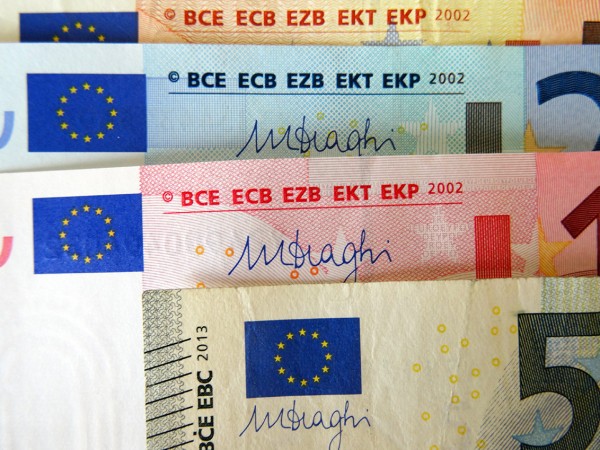 The eurozone recorded 0.0% growth in the second quarter of 2014. While the UK and USA are now experiencing relatively buoyant economic growth, the eurozone as a whole is stagnating. Some of the 18 eurozone countries, it is true, are now growing, including Spain, Portugal, Ireland and the Netherlands. But the German and Italian economies contracted in the three months to the end of June, while France experienced zero growth.
The eurozone recorded 0.0% growth in the second quarter of 2014. While the UK and USA are now experiencing relatively buoyant economic growth, the eurozone as a whole is stagnating. Some of the 18 eurozone countries, it is true, are now growing, including Spain, Portugal, Ireland and the Netherlands. But the German and Italian economies contracted in the three months to the end of June, while France experienced zero growth.
This will put growing pressure on the ECB to introduce quantitative easing (QE) through the direct purchase of government bonds or other assets. Although this has been a key policy of many central banks, including the Bank of England, the Fed and the Bank of Japan, up to now the ECB has focused mainly on providing cheap funds to banks to encourage them to lend and keeping interest rates very low.
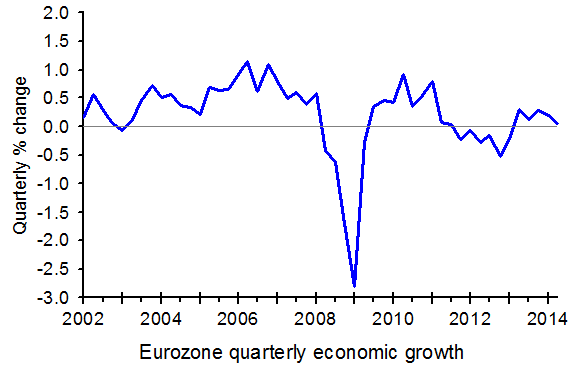
In June, the ECB did announce that it would explore the possibility of QE. It would also introduce €400 billion worth of targeted long-term lending to banks (targeted longer-term refinancing operations (TLTROs)), and would cease sterilising the extra liquidity injected through the Securities Markets Programme, which involved the purchase of existing bonds on the secondary market.
These plans and their implications are examined in the blog post, The ECB: tackling the threat of deflation.
But even if it does eventually introduce QE, this is unlikely before 2015. However, the first €200 billion of TLTROs will be introduced in September and the remaining €200 billion in December. The ECB hopes that these measures in the pipeline will give a sufficient stimulus to rekindle economic growth. But increasingly there are calls for something more dramatic to be done to prevent the eurozone as a whole slipping back into recession.
Articles
Eurozone economy grinds to halt even before Russia sanctions bite Reuters, Michelle Martin and Martin Santa (14/8/14)
ECB under pressure to boost growth, analysts say BBC News (14/8/14)
Eurozone growth at zero as Germany slumps, France stagnates Deutsche Welle (14/8/14)
Eurozone crisis: The grim economic reality BBC News, Gavin Hewitt (14/8/14)
Eurozone growth splutters to a halt as crisis enters new phase The Guardian, Larry Elliott (14/8/14)
Eurozone can learn from George Osborne and Bank of England stimulus The Guardian, Larry Elliott (14/8/14)
Broken Europe: economic growth grinds to a standstill The Telegraph, Szu Ping Chan (14/8/14)
One-in-three chance the ECB conducts quantitative easing next year – Reuters Poll Reuters, Sumanta Dey (13/8/14)
Eurozone’s Unravelling Recovery: What’s Going Wrong Across Troubled Currency Bloc International Business Times, Finbarr Bermingham (14/8/14)
France calls on ECB to act as eurozone growth grinds to a halt The Guardian, Larry Elliott (14/8/14)
That sinking feeling (again) The Economist (30/8/14)
Data
GDP stable in the euro area and up by 0.2% in the EU28 eurostat euroindicators (14/8/14)
Statistics Pocket Book ECB
European Economy: links to data sources Economics Network
Euro area economic and financial data ECB
Questions
- Explain how quantitative easing works.
- Why has the ECB been reluctant to introduce QE?
- What is meant by sterilisation? Why did the ECB sterilise the effects of the assets purchased under the Securities Markets Programme? Why did it cease doing this in June?
- How have events in Ukraine and political reactions to them influenced the eurozone economy?
- Should QE be ‘fast tracked’? Would there be any dangers in this?
- What is the ‘Funding for Lending’ scheme in the UK? Is the planned introduction of TLTROs similar to Funding for Lending?
 The spectre of deflation haunts the eurozone economy. Inflation in the 12 months to May 2014 was 0.5%, down from 0.7% to April and well below the target of 2% (see). Price deflation can result in deflation of the whole economy. With the prospect of falling prices, many consumers put off spending, hoping to buy things later at a lower price. This delay in spending deflates aggregate demand and can result in a decline in growth or even negative growth: hardly a welcome prospect as the eurozone still struggles to recover from the long period of recession or sluggish growth that followed the 2007–8 financial crisis.
The spectre of deflation haunts the eurozone economy. Inflation in the 12 months to May 2014 was 0.5%, down from 0.7% to April and well below the target of 2% (see). Price deflation can result in deflation of the whole economy. With the prospect of falling prices, many consumers put off spending, hoping to buy things later at a lower price. This delay in spending deflates aggregate demand and can result in a decline in growth or even negative growth: hardly a welcome prospect as the eurozone still struggles to recover from the long period of recession or sluggish growth that followed the 2007–8 financial crisis.
The ECB is well aware of the problem. Its President, Mario Draghi, has stated on several occasions that the central bank will do whatever it takes to ward off deflation and stimulate recovery. At its monthly meeting on 5 June, the ECB Council acted. It took the following measures (see Mario Draghi’s press conference and the press release):
• The main refinancing rate it charges banks on reverse repos (when using open-market operations) was cut from 0.25% to 0.15%.
• The rate it pays banks for depositing money in the ECB was cut from 0% to –0.1%. In other words, banks would be charged for ‘parking’ money with the ECB rather than lending it.
• It will provide targeted lending to banks (targeted longer-term refinancing operations (TLTROs)), initially of 7% of the total amount of each banks’ loans to the non-financial private sector within the eurozone. This will be provided in two equal amounts, in September and December 2014. These extra loans will be for bank lending to businesses and households (other than for house purchase). The total amount will be some €400 billion. Substantial additional lending will be made available quarterly from March 2016 to June 2016.
• It will make preparations for an asset purchase scheme. Unlike that in the UK, which involves the purchase of government bonds, this will involve the purchase of assets which involve claims on private-sector (non-financial) institutions. Depending on financing arrangements, this could amount to quantitative easing.
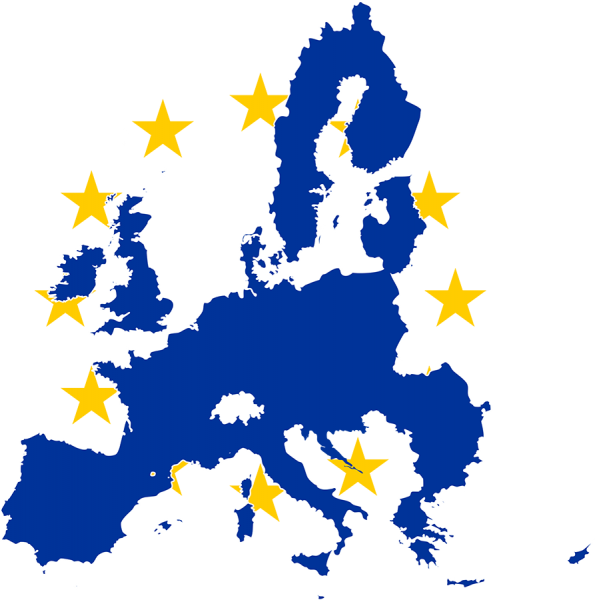 • It will suspend sterilising the extra liquidity that has been injected under the Securities Markets Programme (operated from May 2010 to September 2012), which involved purchasing eurozone countries’ existing bonds on the secondary market. In other words it will stop preventing the securities that have been purchased from increasing money supply. This therefore, for the first time, represents a genuine form of quantitative easing.
• It will suspend sterilising the extra liquidity that has been injected under the Securities Markets Programme (operated from May 2010 to September 2012), which involved purchasing eurozone countries’ existing bonds on the secondary market. In other words it will stop preventing the securities that have been purchased from increasing money supply. This therefore, for the first time, represents a genuine form of quantitative easing.
The question is whether the measures will be enough to stimulate the eurozone economy, prevent deflation and bring inflation back to around 2%. The measures are potentially significant, especially the prospect of quantitative easing – a policy pursued by other main central banks, such as the Fed, the Bank of England and the Bank of Japan. A lot depends on what the ECB does over the coming months.
The following articles consider the ECB’s policy. The first ones were published before the announcement and look at alternatives open to the ECB. The others look at the actual decisions and assess how successful they are likely to be.
Articles published before the announcement
Mario Draghi faces moment of truth as man with power to steady eurozone The Observer, Larry Elliott (1/6/14)
What the ECB will do in June? Draghi spells it out The Economist (26/5/14)
Draghi as Committed as a Central Banker Gets, as Economists Await ECB Stimulus Bloomberg, Alessandro Speciale and Andre Tartar (19/5/14)
ECB’s credit and credibility test BBC News, Robert Peston (2/6/14)
90 ECB decamps to debate monetary fixes Financial Times, Claire Jones (25/5/14)
Speech
Monetary policy in a prolonged period of low inflation ECB, Mario Draghi (26/5/14)
Articles published after the announcement
ECB launches €400bn scheme, seeks to force bank lending Irish Independent (5/6/14)
The ECB’s toolbox BBC News, Linda Yueh (5/6/14)
ECB’s justified action will help but is no panacea for eurozone deflationary ills The Guardian, Larry Elliott (5/6/14)
Why Negative Rates Won’t Work In The Eurozone Forbes, Frances Coppola (4/6/14)
Germany’s fear of QE is what’s stopping us from cracking open the Cava The Telegraph, Roger Bootle (8/6/14)
Data
Euro area economic and financial data ECB
Questions
- Why has the eurozone experienced falling inflation and a growing prospect of negative inflation?
- Explain how the Securities Markets Programme (SMP) worked (check it out on the ECB site). What countries’ bonds were purchased and why?
- What is meant by sterilisation? Why did the ECB sterilise the effects of the assets purchased under the SMP?
- If it is practical for the ECB to set a negative interest rate on the deposit facility for banks, would it be practical to set a negative interest rate for the main refinancing operations or the marginal lending facility? Explain.
- Why has the ECB, up to now, been unwilling to engage in quantitative easing? What has changed?
- Why may the introduction of a negative interest rate on bank deposits in the ECB have only a very small effect on bank lending?
- How much is broad money supply growing in the eurozone? Is this enough or too much? Explain.
- What else could the ECB have done to ward off deflation? Should the ECB have adopted these measures?
 In August 2012, the ECB president, Mario Draghi, said that the ECB would ‘do whatever it takes‘ to hold the single currency together and support the weaker economies, such as Greece, Portugal and Spain. At the same time, he announced the introduction of outright monetary purchases (OMTs), which would involve purchasing eurozone countries’ bonds in the secondary markets. There were no limits specified to such purchases, but they would be sterilised by the sale of other assets. In other words, they would not increase the eurozone money supply. But despite the fanfare when OMTs were announced, they have never been used.
In August 2012, the ECB president, Mario Draghi, said that the ECB would ‘do whatever it takes‘ to hold the single currency together and support the weaker economies, such as Greece, Portugal and Spain. At the same time, he announced the introduction of outright monetary purchases (OMTs), which would involve purchasing eurozone countries’ bonds in the secondary markets. There were no limits specified to such purchases, but they would be sterilised by the sale of other assets. In other words, they would not increase the eurozone money supply. But despite the fanfare when OMTs were announced, they have never been used.
Today, the eurozone economy is struggling to grow. The average annual growth rate across the eurozone is a mere 0.5%, albeit up from the negative rates up to 2013 Q3. GDP is still over 2% below the peak in 2008. Inflation is currently standing at 0.8%, well below the 2% target. The ECB’s interest rate (‘main refinancing operations rate’) is 0.25%.
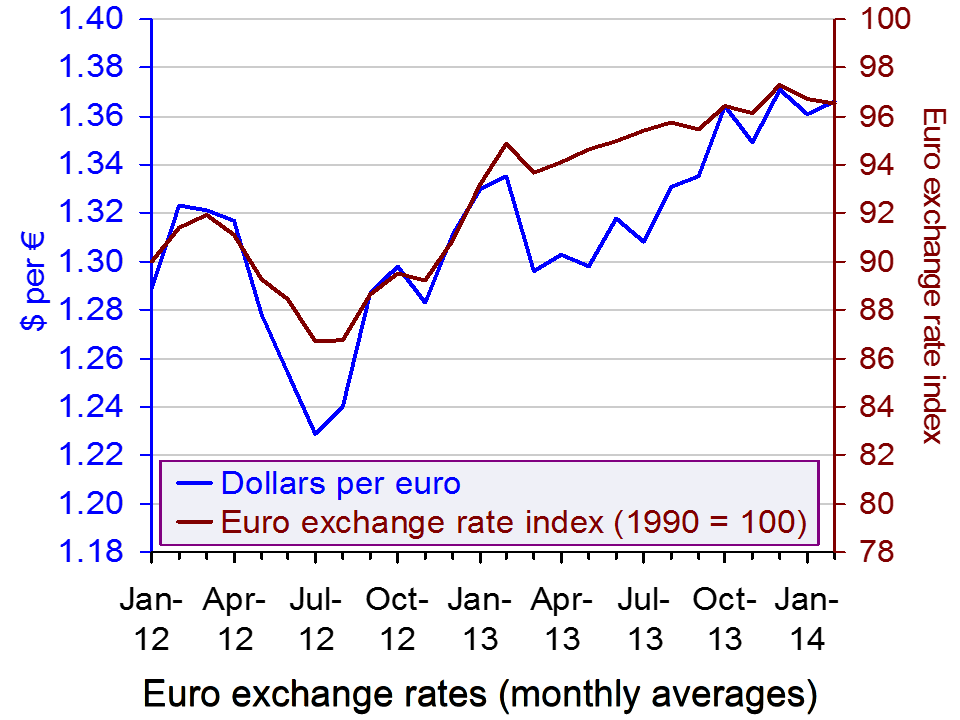
The recovery is hindered by a strong euro. As the chart shows, the euro has been appreciating against the dollar. The euro exchange rate index has also been rising. This has made it harder for the eurozone countries to export.
So what can the ECB do to stimulate the eurozone economy? Other central banks, such as the Bank of England, the US Federal Reserve and the Bank of Japan have all had substantial programmes of quantitative easing. The ECB has not. Perhaps OMTs could be used without sterilisation. The problem here is that there are no eurozone bonds issued by the ECB and hence none that could be purchased, only the bonds of individual member countries. Buying bonds of weaker countries in the eurozone would be seen as favouring these countries and might create a moral hazard.
Reducing interest rates is hardly an option given that they are at virtually zero already. And expansionary fiscal policy in the weaker countries has been ruled out by having to stick to the bailout conditions for these countries, which require the pursuit of austerity policies.
One possibility would be to intervene in the foreign currency market by buying US and other countries’ bonds. This would drive down the euro and provide a stimulus to exports. This option is considered in the Jeffrey Frankel article.
Articles
Why the European Central Bank should buy American The Guardian, Jeffrey Frankel (13/3/14)
Draghi holds course in face of deflation threat Reuters, Paul Carrel and Leika Kihara (13/3/14)
ECB’s Draghi: Strong Euro Pulling Down Euro Zone Inflation Wall Street Journal, Christopher Lawton and Todd Buell (13/3/14)
Draghi Bolstering Guidance Seen as Convincing on Rates Bloomberg, Jeff Black and Andre Tartar (13/3/14)
ECB president Mario Draghi counters euro upswing Financial Times, Claire Jones (13/3/14)
Turning Japanese? Euro zone exporters must hope not Reuters, Neal Kimberley (14/3/14)
Prospect of ECB QE drives eurozone bond rally Financial Times, Laurence Mutkin (12/3/14)
Data
Statistical Data Warehouse ECB
Winter forecast 2014 – EU economy: recovery gaining ground European Commission: Economic and Financial Affairs DG
AMECO online European Commission: Economic and Financial Affairs DG
Questions
- Why is the ECB generally opposed to quantitative easing of the type used by other central banks?
- What is meant by ‘sterilisation’? Why does sterilisation prevent OMTs being classed as a form of quantitative easing?
- Would it be possible for OMTs to be used without sterilisation in such as way as to avoid a moral hazard for the highly indebted eurozone countries?
- Is the eurozone in danger of experiencing deflation?
- What are the dangers of deflation?
- Why does the ECB not cut its main refinancing rate below zero?
- If the ECB buys US bonds, what effect would this have on the euro/dollar exchange rate?
- Would purchasing US bonds affect the eurozone money supply? Explain.
- What other means are there of the ECB stimulating the eurozone economy? How effective would they be likely to be?
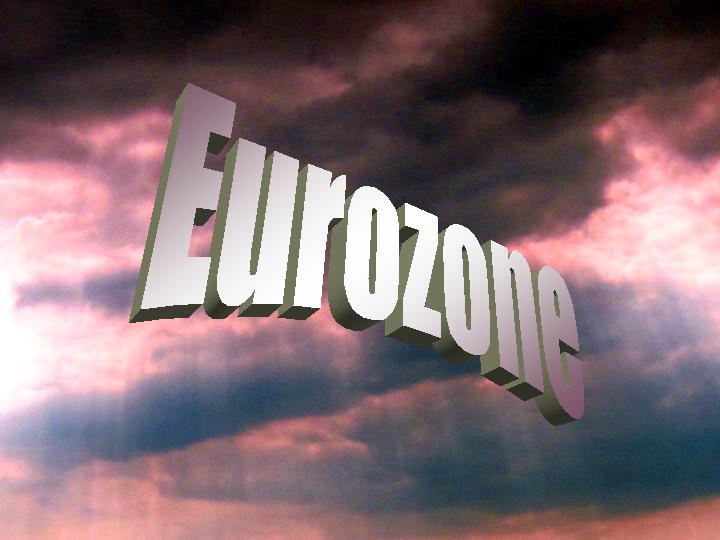 ‘Deflation could be replacing debt as the main problem – and there’s nothing to suggest the ECB is up to the job.’ So begins the linked article below by Barry Eichengreen, Professor of Economics and Political Science at the University of California, Berkeley.
‘Deflation could be replacing debt as the main problem – and there’s nothing to suggest the ECB is up to the job.’ So begins the linked article below by Barry Eichengreen, Professor of Economics and Political Science at the University of California, Berkeley.
The good news in this is that worries about debt in eurozone countries are gradually receding. Indeed, this week Ireland officially ended its reliance on a bailout (of €67.5 billion) from the EU and IMF and regained financial sovereignty (see also).
The bad news is that this does not mark the end of austerity. Indeed, many eurozone countries could get stuck in a deflationary trap, with austerity policies continuing to depress aggregate demand. Eurozone inflation is less than 1% and falling.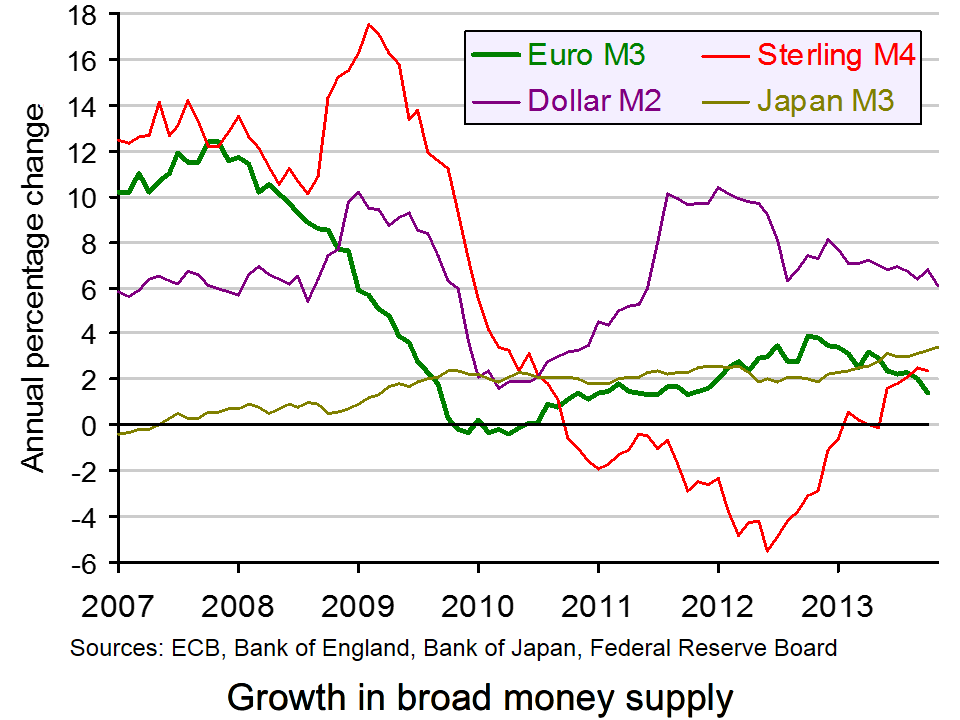 Broad money supply growth is now below that of the US dollar, the yen and sterling (see chart: click here for a PowerPoint).
Broad money supply growth is now below that of the US dollar, the yen and sterling (see chart: click here for a PowerPoint).
The ECB has been far more cautious than central banks in other countries in acting to prevent recession and deflation. Unlike the USA, Japan and the UK, which have all engaged in extensive quantitative easing, the ECB had been reluctant to do so for fear of upsetting German opinion and taking the pressure off southern European countries to reform.
But as Eichengreen points out, the dangers of inaction could be much greater. What is more, quantitative easing is not the only option. The ECB could copy the UK approach of ‘funding for lending’ – not for housing, but for business.
Europe’s economic crisis could be mutating again The Guardian, Barry Eichengreen (10/12/13)
Questions
- What problems are created by falling prices?
- What effect would deflation have on debt and the difficulties in repaying that debt?
- What measures have already been adopted by the ECB to stimulate the eurozone economy? (Search previous articles on this site.)
- Why have such measures proved inadequate?
- What alternative policies are open to the ECB?
- What are the arguments for the ECB being given a higher inflation target (such as 3 or 4%)?
- What are the arguments for and against relaxing fiscal austerity in the eurozone at the current time?
 As we saw in the blog post last month, Eurozone becalmed the doldrums, the eurozone economy is stagnant and there is a growing danger that it could sink into a deflationary spiral. Last month, several new measures were announced by the ECB, including a negative interest rate on money deposited in the ECB by banks in the eurozone. This month, the ECB has gone further including, for the first time, a form of quantitative easing.
As we saw in the blog post last month, Eurozone becalmed the doldrums, the eurozone economy is stagnant and there is a growing danger that it could sink into a deflationary spiral. Last month, several new measures were announced by the ECB, including a negative interest rate on money deposited in the ECB by banks in the eurozone. This month, the ECB has gone further including, for the first time, a form of quantitative easing. Draghi Sees Almost $1 Trillion Stimulus as QE Fight Waits Bloomberg, Simon Kennedy (5/9/14)
Draghi Sees Almost $1 Trillion Stimulus as QE Fight Waits Bloomberg, Simon Kennedy (5/9/14) Webcast of the press conference 4 September 2014 European Central Bank, Mario Draghi, President of the ECB (4/9/14)
Webcast of the press conference 4 September 2014 European Central Bank, Mario Draghi, President of the ECB (4/9/14)





